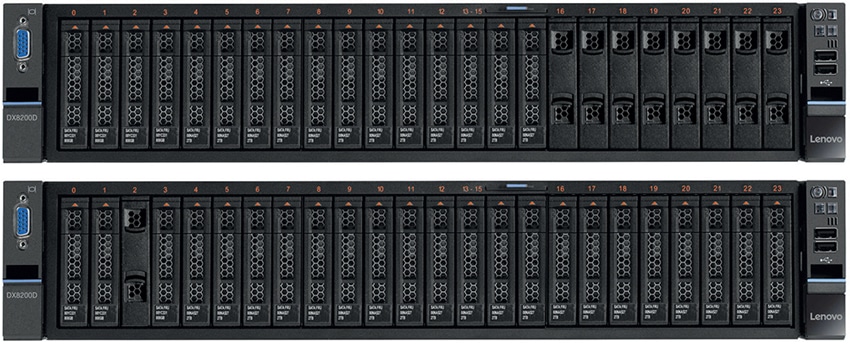Today Lenovo announced its new turnkey software-defined storage (SDS) appliance, the DX8200D. The DX8200D leverages Lenovo’s x3650 M5 server platform and combines it with DataCore’s storage virtualization software, SANsymphony. The new DX8200D builds off of Lenovo’s other SDS offerings announced last year.

In order to simplify deployment and management, the DX8200D will be offered as a pre-integrated appliance. According to Lenovo, the new SDS appliance will enable data centers to rapidly deploy a turnkey solution that harnesses the capabilities of existing SAN arrays. For data centers with heterogeneous storage infrastructure, the DX8200D can help with optimization, scaling as needed, and make it easier for companies to replace older equipment that will no longer be necessary. The DX8200D offers data protection, replication, de-duplication, compression, and other enterprise storage capabilities through a centralized interface.
DX8200D is designed to take isolated storage devices, sometimes spread between different locations, and place them under one common set of enterprise-wide services. This means it can pool the collective resources of the equipment for the benefit of the customers, even if these storage devices are different models, have different manufacturers, are different generations, or are typically incompatible with one another. This should lower total cost of ownership. Lenovo goes on to state that companies can see up to 90% decrease in time spend on storage management and support tasks, up to a 75% reduction in storage costs, up to 100% reduction in storage-related downtime, with a 10-fold increase in performance.
Lenovo states that by putting DX8200D on the x3650 M5 server they can deliver the highest levels of response times, availability, and utilization. The x3650 comes with Predictive Failure Analysis and easy serviceability to help keep downtime to a minimum. Each server with DataCore software is pretested to reduce deployment risks while increasing time to value.
Features and benefits include:
- Unified, scalable storage platform with up to 64 nodes in a managed group for high availability and performance
- Flexible host connectivity to match diverse client needs for unified file and block storage with support for a mix of 10 GbE interfaces for NFS, CIFS, and SMB NAS or iSCSI SAN storage connectivity, as well as optional 16 Gb Fibre Channel interfaces for FC SAN storage connectivity
- Flexibility in managing data on external virtualized storage and local node storage
- Rich set of standard functions, including internal and external storage virtualization, thin provisioning, tiering, load balancing, compression, deduplication, mirroring, data migration, and multiprotocol support
- Optional licensed functions, including continuous data protection, asynchronous replication, and Fibre Channel support
- VMware vSphere Virtual Volumes (VVol) integration brings advanced storage management functions to the virtual machine level for finer VM storage service level control and policy-driven automation
- Application GUI for easy system set up and management
- Extensive interoperability with support for most major storage platforms and operating systems
Using Lenovo XClarity software, the Lenovo DX8200D is able to centrally automate discovery, inventory tracking, real-time monitoring, configuration, fault detection, and alert handling over its lifecycle.




 Amazon
Amazon